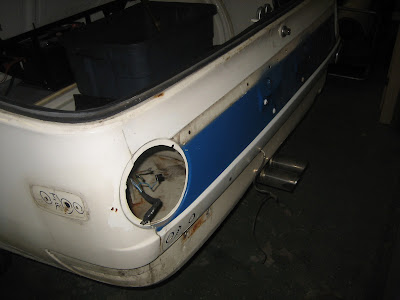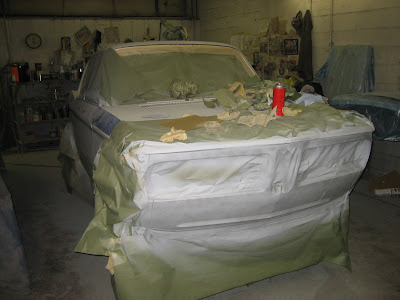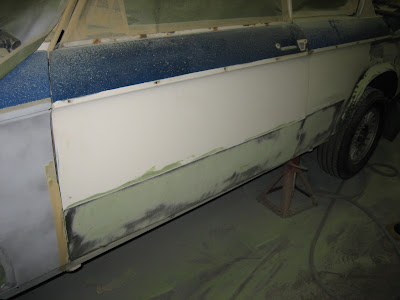As 2011 came to a close, I had a bit of a setback with the 944. I had buttoned the new motor into the car and was ready to move onto the host of other items I planned for the coming season. I ran the motor for a half hour to bring it up to temp and bleed the coolant. As the temps came up, the oil pressure started dropping. Not usually a concern. As the oil heats up, it starts to thin out a bit. Idling at 1000 rpm, it was showing 3 bars. Then 2 bars. Blipping the throttle to 4K would bounce the pressure back up to 4.5 bars and life was good. But I wasn't getting off that easy.
Soon it dropped to 1.5 bars at idle, and blipping the throttle would only go to 3, then 2 and then no effect. Shit! Shut it down and regroup.
Thinking and talking to some engine folks, and the consensus was either OPR value or still some shavings from the rod bearing failure clogging up the oil system. Draining the oil I found some small metal flakes on the drain plug magnet. So the only course of action was to to, of course, pull the motor. Man I'm glad I'm being paid by the hour for this crap!
 |
| Out again, hopefully for the last time in 2011. |
I found some rod bearing flakes on the oil pickup. I pulled the bottom end and the oil cooler off. Threw the oil cooler in the trash and found a slug of flakes blocking the OPRV. Replaced that too. To play it safe I pulled the main cradle and checked the main and rod bearings and clearance. The mains looked fine, but one of the rod bearing was lightly scored, so replaced all of them again. Checked all the passages with compressed air and a magnet, and it looked good, so I put it back together again.
 |
| Crankshaft and mains exposed. |
 |
| Adding the high dollar Locktite sealant to the crank cradle |
With the lump back in the car, fluids topped off, DME relay pulled and coil disconnected - a short sentence, but 4 hours of work - I cranked the starter, and within a few seconds, I had 5 bars of oil pressure. Excellent, first time that has ever happened to me without having to fire the motor. I connected the ignition bits and it fired right up. 40 minutes later, the coolant was bled, and I still had great oil pressure. I think I turned the corner.
Of course, for the next week, I would sneak out to the garage at night and start the motor and let it run for a bit, "just to take a look". So far so good, I'm starting to believe. So now its buttoned up in the trailer, ready to go to John Behe's shop, for a break-in on the dyno and a tuning session.
So with that behind me it was time for something else on my garage to do list.
First up was a new radiator for the Subie. With the 944 taking up my lift, I had farmed out a new clutch job to the local Subaru dealer.It was gone and I just didn't have the time or lift for it. While it was there, the Service Rep called me up and told me my radiator was leaking and needed replacement. Also said in an accusatory tone:
Somebody put a "aftermarket" radiator in the car. I let this sink in for a bit, and then said that "
Somebody" was you, the dealer. You replaced it about 2 years ago! Oh, she said, and then, but that doesn't matter, it's out of warranty anyway. I declined the extra $600 to be added to my bill.
I ended up finding the best price on Amazon of all places and one afternoon went to work.
 |
| A true Aftermarket radiator. Pretty nice aluminum piece, much better than stock. |
 |
| Rad and new hoses in place. |
For good measure, I added a set of silicon hoses. A couple of easy hours work and I saved $300 bucks from the dealer price and have a much better product. I should be good for another 120K miles.
Which brings us to the project pictured at the top of this entry. After owning the 1970 BMW 2002 for several years, and generally restoring the mechanical bits, it was time to make it purdy.
Last weekend I started on the disassembly and engine removal. Pulling motors is what I do!
I'm having the car repainted. Along with the painting, there some minor rust repair, shaving of the US markers, the lower side trim and I want the engine compartment painted too. So all the trim and the motor need to come off or out.
To have a hope in hell of putting it all back together again, I'm taking lots and lots of pictures.
 |
| typical photo, this is the throttle rod assembly. |
 |
| Motor about ready to come out. |
I'll be pulling the motor from the bottom, disconnecting all the misc bits, and then dropping the suspension with the motor and tranny still attached. Slide the assembly out from front of the car, pick the motor off and put it on the stand, reattach the suspension and done. Same process I used to do with my 944 motors. I ran out of time last weekend, but am close. I'll wait until the weekend and daylight hours to finish it up. Meanwhile I am pulling all the trim off. That's enough to keep me busy after work.
 |
| Bumper, lights and rear trim all gone. |
 |
| Rear seats and interior panels had to go to get to bolts holding side trim. |
 |
| Front turbo spoiler, grilles and headlights gone. hood trim also. |
 |
| Notes to the body shop. This is the front fender where there was US reflectors attached when the car was imported. They are going and the holes welded over. |






































